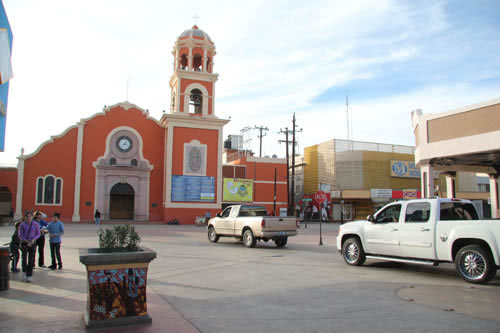Pedestrian Space Overrun by Cars, Mexicali on Road to Ecological Disaster
MEXICALI
The dismantling of the city's only pedestrian walkway has generated public discontent in a city that suffers from deplorable air quality and which is heading down the road to urban and ecological disaster.
The administration of Jaime Díaz Ochoa, Mexicali's new mayor from the PAN party, eliminated a 200 yard long pedestrian corridor that had recently debuted for the enjoyment of Mexicali's families in the center of the historic capital city.
The pedestrian project, identified as the first stage in the revival of the city's historical center, had an investment of US$1.44 million in order to remove the asphalt roadway and replace it with a surface designed exclusively for pedestrians with integrated planters, benches, and shade. The new space created a venue for open-air cultural events which thousands of families were able to attend.
The only public works project in at least the last ten years dedicated to non-motorized mobility had a useful life of just four months; it was reopened to automobile traffic at the beginning of December 2013.
When it comes to air quality, Mexicali is one of Mexico's and the world's worst cities because of the excessive number of cars. It is estimated that there are at least 1.5 cars per inhabitant.
The dismantling of the walkway without public consultation or advice from experts contradicts the recommendations of the Institute for Transportation and Development Policy (ITDP) that establishes priorities for urban mobility as follows: pedestrians first, then cyclists, followed by public transportation, cargo transportation, and finally cars.
The municipality of Mexicali has done things backwards: they have given special consideration to automobiles by diverting public investment earmarked for pedestrians.
According to a study from the Mexican Institute for Competitiveness (IMCO in Spanish), this is all happening in an environment where, since 2010, the metropolitan area has registered an average rate of 30 deaths per year related to the effects of air pollution, such as respiratory and cardiovascular diseases.
Meanwhile, reports from the World Health Organization points out that since 2008 Mexicali has been one of the world's top 20 cities with the highest average concentration of fine particulate matter (PM2.5), registering 51 µg/m³ (micrograms per cubic meter); when international guidelines recommend a yearly average of no greater than 10µg/m³.
In the opinion of the IMCO, the capital city suffers from unacceptable air quality which has resulted in 283 deaths and more than US$2.5 million spent on health care since 1990.

